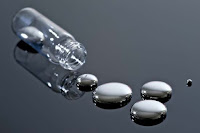Mercury is a heavy, silver-colored element. It is the only common metal which is LIQUID at room temperatures. The Latin name for it is hydrargyrum, meaning "liquid silver," which it very much resembles. Mercury is really not a form of silver, although a common name for it is quicksilver. Owing to its weight and fluid form, it slips out of grasp most readily.
Mercury occurs free in nature but is principally obtained from an ore called CINNABAR, a red sulfide of mercury. This is heated, and vapors of the element are condensed and processed to purity.
Mercury is useful for THERMOMETERS, as it does not cling to the walls of the tube. Since it has a higher BOILING POINT than alcohol, it is used where temperatures are high. Mercury also serves in other instruments including BAROMETERS, where its weight is desirable, because the atmosphere supports a column thirty inches high.
Mercury can combine with other metals by being worked into them. These combinations are called amalgams. Dentists use amalgams of silver and gold for fillings.
Mercury (symbol Hg from Latin hydrargyrum) has atomic number 80. Its atomic weight is 200.59 (200.61, O= 16). Some of its compounds are poisonous.
Mercury occurs free in nature but is principally obtained from an ore called CINNABAR, a red sulfide of mercury. This is heated, and vapors of the element are condensed and processed to purity.
Mercury is useful for THERMOMETERS, as it does not cling to the walls of the tube. Since it has a higher BOILING POINT than alcohol, it is used where temperatures are high. Mercury also serves in other instruments including BAROMETERS, where its weight is desirable, because the atmosphere supports a column thirty inches high.
Mercury can combine with other metals by being worked into them. These combinations are called amalgams. Dentists use amalgams of silver and gold for fillings.
Mercury (symbol Hg from Latin hydrargyrum) has atomic number 80. Its atomic weight is 200.59 (200.61, O= 16). Some of its compounds are poisonous.
